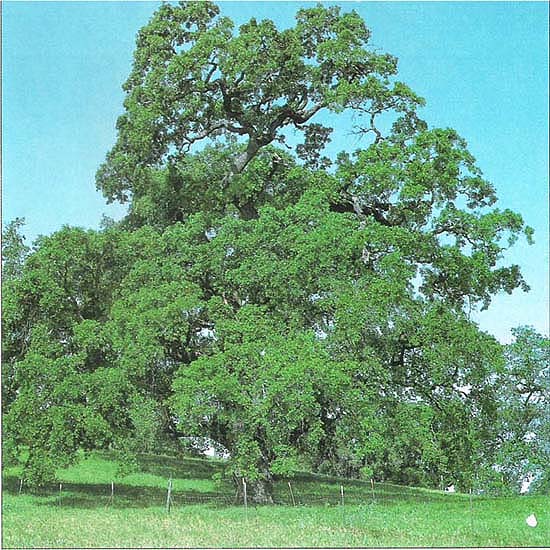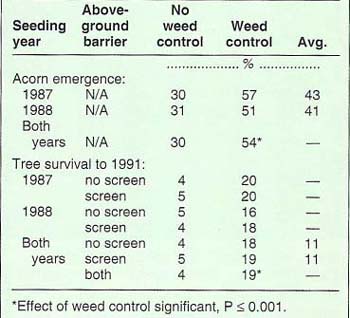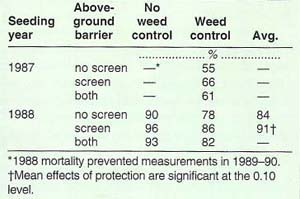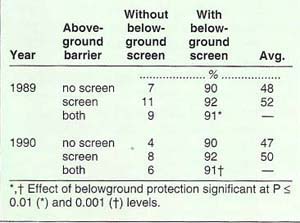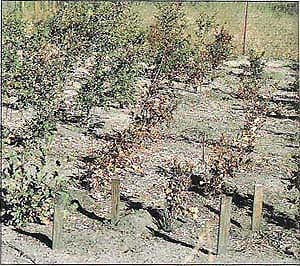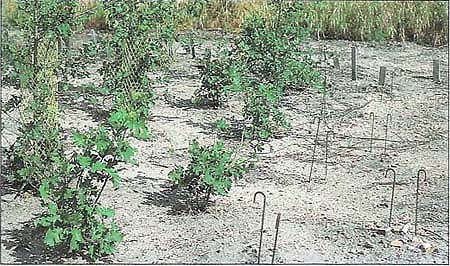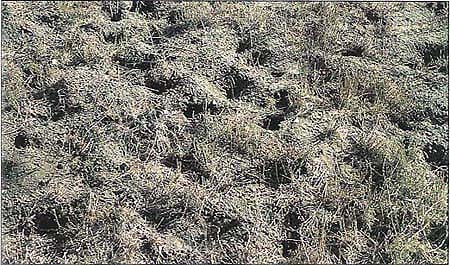All Issues
Gophers love oak — to death
Publication Information
California Agriculture 46(5):27-29.
Published September 01, 1992
PDF | Citation | Permissions
Abstract
Weed competition, insects, and small mammals all account for oak seedling loss. High populations of pocket gophers, as at Lopez Lake County Park in San Luis Obispo County, can destroy 90% of 2 to 3-month-old transplanted valley oak seedlings in the first year. Without effective protection from pocket gophers, any control of or protection from other small mammals and control of competition may be of little value
Full text
It may be a magnificent specimen, but this California valley oak is regenerating poorly for a variety of reasons, including pocket gopher attacks on its seedlings.
California's loss since 1945 of an estimated 1 million of its 7.5 million acres of noncommercial oak woodland has been compounded by a relatively sparse recruitment in blue oak (Quercus douglasii) stands, which occupy about 3 million acres, and an almost nonexistent recruitment in valley oak (Q. lobata) stands. Studies of age class survival suggest that unsuccessful recruitment results from tree mortality in the seedling and sapling stages, rather than from inadequate germination and seedling emergence.
To assess selected mortality factors affecting artificial plantings of oaks in oak woodlands, we examined the influence of feeding by pocket gophers (Thomomys bottae) on valley oak in Lopez Lake County Park, San Luis Obispo County. This study was an outgrowth of efforts to assess the influence of weeds and herbivorous mammals and insects on the emergence, survival, and growth of seedlings that had developed from hand-sown acorns and to assess the survival and growth of transplanted 2- to 3-month-old nursery stock. These studies are intended to help develop the restocking techniques needed to preserve oak woodlands.
Study site
The planting site is at an elevation of 500 feet, 12 miles inland from the coast. Its soil, a deep alluvium, Elder sandy loam, supports natural stands of valley oak. The average annual precipitation of about 20 inches has been less during 6 years of drought. Annual grasses and forbs dominate the vegetation and grow until all available soil water is exhausted.
Methods
The acorns planted by direct seeding at the growing site in late fall (November and December) in 1987 and 1988 represented local ecotypes and were collected from trees from late summer through early fall. The collections from both years provided plant material for nursery propagation. The 2- to 3-month-old seedlings that these materials produced were transplanted during February and March of 1988 and 1989.
In each of the four trials established — two seeding trials (1987 and 1988) and two transplant trials (1988 and 1989) — plant material was evenly spaced in parallel rows away from any tree canopies and on ground as flat as possible to minimize the influence of slope exposure and inclination on sunlight intensity. All trials were conducted within a deer-proof enclosure to prevent deer and livestock from browsing seedlings.
Treatments in the seeded acorn trials were applied as a randomized complete block design, and included two levels of weed control (complete control and no control) as main plots and two levels of aboveground protection against small mammal damage (screens and no screens) as a split on main plots.
Nursery stock was planted with complete weed control, accomplished with chemicals and hoeing. Weed control was established at the time of planting and has been maintained continuously.
Two levels of aboveground protection against small mammals, organized in a randomized complete block design, were included in the 1988 trial, and poison bait was used to minimize gopher damage. In the 1989 trial, aboveground protection was applied as a split on main plots consisting of two levels of protection against gophers (belowground screens and no screens). Again, a randomized complete block design was used, but no effort was made to control gophers.
Screens used to protect against aboveground predation by small mammals were 14-strand, rigid plastic seedling protectors 2 inches in diameter and 15 inches high, manufactured by Forest Protection Products Co., Inc., Coos Bay, Oregon. Following emergence in the seeded trials, seedlings in each replicate were divided into two groups, protected and unprotected, with screens applied randomly. In the nursery stock trials, screens were applied after planting. In all trials, screens were held in place with 9-gauge steel pins 18 inches long.
TABLE 1. Emergence and 1991 survival of valley oak (as percentage of acorns planted) seeded in 1987 and 1988 at Lopez Lake County Park, San Luis Obispo County
TABLE 2. Percentage of valley oak seedlings killed by pocket gophers in 1989 and 1990, for seedings planted in 1987 and 1988 at Lopez Lake County Park, San Luis Obispo County
TABLE 3. 1989 and 1990 survival of 2- to 3- month-old valley oak nursery stock planted in March 1989 at Lopez Lake County Park, San Luis Obispo County
Gopher protection for seedlings in the 1989 planting of nursery stock was provided as individual underground tubes of rolled and stapled aluminum window screen 2 inches in diameter and 18 inches long. Planting holes were augered 18 inches deep, the tubes were placed in the holes and partially filled with tamped soil, and the seedlings were planted in the last 6 inches of the tubes. Manufacture and installation of each tube was no more difficult than setting a gopher trap. As each seedling grows, the expanding root mass puts pressure on the screen tube, which oxidizes slowly, the rusted staples will break, and the tubes should gradually open along the seam.
Aluminum window screen was selected because its fine mesh was expected to discourage penetration by most lateral roots, it was readily available, and it was easy to work with. Root penetration through a larger-mesh screen, such as hardware cloth, could impair plant growth and root development as roots were constricted by the confining openings in the screen.
Data evaluated by analysis of variance included seedling emergence, tree survival in the spring of each growing season, and tree heights each fall. In measuring height, the longest stem was used if branching occurred. Unless otherwise noted, significant differences were identified at the 95% level of confidence or greater.
Results
In the two seeding trials, average emergence with weed control was 80% greater (table 1), a highly significant difference (P ≤ 0.001). Survival through spring of 1991 was nearly five times greater with weed control (table 1), but survival in this treatment was only about one-third of the emergence that occurred.
Although aboveground screen protection had no influence on survival in the seeding trials (table 1), height of protected plants in the two trials, measured in fall 1991, was 75 to 100% greater, a significant difference (P ≤ 0.05). Average height with protection in both trials was 8 inches. Without protection, height was 6 inches in the 1987 trial and 4 inches in the 1988 trial.
Both seedings suffered heavily from gopher depredations (table 2). During 1989 and 1990, nearly two-thirds of all mortality in the 1987 weed control treatment was caused by gophers. Screened seedlings suffered more in this treatment, but the difference was not significant. Our inability to sustain early efforts at control using poisoning contributed to these results.
In the 1987 seeding, it was not possible to measure the gophers' contribution to tree mortality in the treatment without weed control. Mortality caused by competition during the first growing season left too few seedlings to provide such a measure.
Pocket gophers caused significant losses of 3-year-old valley oak seedlings at Lopez Lake in 1991 after chemical control ceased. The seedlings had been planted from nursery stock.
During the same 2-year period, average gopher-caused mortality in the 1988 seeding was 90% of the total for the complete weed control and no weed control treatments (table 2). As in the 1987 seeding trial, more screened seedlings suffered, and the difference was weakly significant (P ≤ 0.10).
In the 1988 nursery stock planting, survival through the first year with and without aboveground screen protection (measured in spring 1989) was not different; survival averaged 60%. The primary cause of loss was drought; gopher predation was minimal because a small population was present and poison bait control was practiced the first season. By spring, 1991, average survival declined to 44%, again with no difference between screened and unscreened treatments. Of this additional loss, gophers were responsible for 92% of the losses in the formerly screened treatment (screens had by now been destroyed by photodecomposition) and for 79% of the losses in the treatment that had been unscreened all along, but the difference was not statistically significant. Gophers became an important cause of loss when control measures could not be sustained after the 1988–1989 season.
Measured in 1990, the heights of all seedlings in the planting of 1988 nursery stock did not differ significantly, averaging nearly 3 feet. As the plants matured, the early significant difference in height recorded in 1989, when protected plants were taller, was not sustained.
The 1989 planting of nursery stock included screen protection both above and below the ground. As in the other plantings, plastic screens did not significantly influence survival (table 3), but the belowground screens had a dramatic effect. More than 95% of the seedlings not protected from gophers were lost in the first year. Of the less than 10% mortality among seedlings protected from gophers, only 13% are suspected to have been caused by this pest.
Nearly all of the valley oak nursery stock planted without underground protection from pocket gophers at Lopez Lake in 1989 has been destroyed. The steel pins once used to hold aboveground screens in place remain to mark the lost trees.
Oak woodland sites with evidence of high pocket gopher populations, such as this one near the Lopez Lake plantings, are poor candidates for restoration unless oak seedlings are protected.
After 3 years, the height of seedlings protected by aboveground screens in the 1989 nursery stock planting remained significantly greater (P ≤ 0.05). Trees protected from gophers by aboveground plastic screens were nearly 30 inches tall; those without aboveground protection were 20 inches tall.
Because mortality data suggested that aboveground screen protection in the direct seeding trials and in the 1988 planting of nursery stock may have influenced gopher damage, data for gopher-caused mortality from these trials were pooled and analyzed. Of the mortality occurring from 1989 through 1990, the average loss from gophers was greatest among protected plants (81% versus 71%). This difference was weakly significant (P ≤ 0.10).
Discussion
In the seeding trials, weed competition clearly stifled both emergence and survival at Lopez Lake. This supports measurements made in other trials of both blue oak and valley oak conducted at several locations in California beginning in fall, 1985. Earlier work by others also demonstrated that reduced precipitation, combined with annual grass competition, greatly reduced blue and valley oak seedling establishment.
Our observations and those of others in California are not unique. Throughout the East, Midwest, and Canada, the benefits of controlling herbaceous vegetation to promote survival and growth of oaks and other naturally and artificially propagated hardwoods are well documented.
The ineffectiveness of aboveground screening at Lopez Lake was surprising. However, the difference in height between protected and unprotected seedlings at Lopez Lake is evidence of attack by small mammals such as rabbits. Statewide, such protection generally has been beneficial, and where grasshoppers are a chronic problem, window screen protection has been highly beneficial to both survival and growth. Where ground squirrels and rabbits have significantly harmed unprotected oak seedlings, plastic screens have proved valuable. In the eastern United States, rodents constitute the chief obstacle to reproducing oaks from seeded acorns.
Gopher menace
The described influences on oak regeneration occur widely in California, but at Lopez Lake loss to gophers is an additional major problem. In a heavily infested site like Lopez Lake, this can mean nearly total destruction of unprotected seedlings, as was observed in the 1989 planting of nursery stock. Considering the investment such plantings represent and the effect gophers can have on restoration efforts, underground screen protection may be a necessity in many plantings. Without this protection, control of or protection from other small mammals and control of weed competition may be of little value.
Oxidation of buried aluminum screen is slow. When the seedlings protected from gophers in the 1989 planting are larger, probably in two more years, some will be sacrificed to assess the possible impact of screens on root development. However, any modification or impairment of growth that may be observed is not expected to outweigh the value of the screens.
In plantings where only aboveground screens protected half the seedlings, the differences in loss between protected and unprotected plants may have been an indication of particular plant characteristics. Protected seedlings may have been more attractive to gophers because they were healthier than unprotected seedlings, but this is speculation.
At Lopez Lake, gopher populations have been variable both in time and space. Nearby oak plantings initiated before those discussed here have suffered less from gopher predation. Initial control efforts using poison bait and targeting a relatively small population permitted most seedlings that survived other environmental effects to outgrow susceptibility to attack.
The gopher problem as it has developed at Lopez Lake represents a situation that exists or has the potential to develop elsewhere. In Madera County, blue oak seedlings growing weed-free with supplemental summer irrigation have been attacked by gophers. In this situation, the water applications can be presumed to have attracted the rodents by improving burrowing conditions.
In all of our work, the concentration of plant material, acorns, and nursery stock in geometric patterns may have contributed to attack; some animals can identify planting patterns and thus learn where to search for planted material as food. Restocking programs that approximate natural distributions of oak should be less vulnerable to detrimental insects and small mammals whose populations often fluctuate in time and space.
Weed competition and rodent damage often are linked. In our studies, the use of deer-proof exclosures and the consequent elimination of livestock grazing allowed uncontrolled herbaceous growth in areas where no weed control was practiced. The habitat thus created encouraged development of populations of meadow voles (Microtus spp.) that, at some sites, seriously threaten oak seedling survival. Qualitative observations suggest not only that control of herbaceous growth discourages the voles, but that over time it also may help control pocket gopher populations by limiting potential food resources over relatively large areas.



